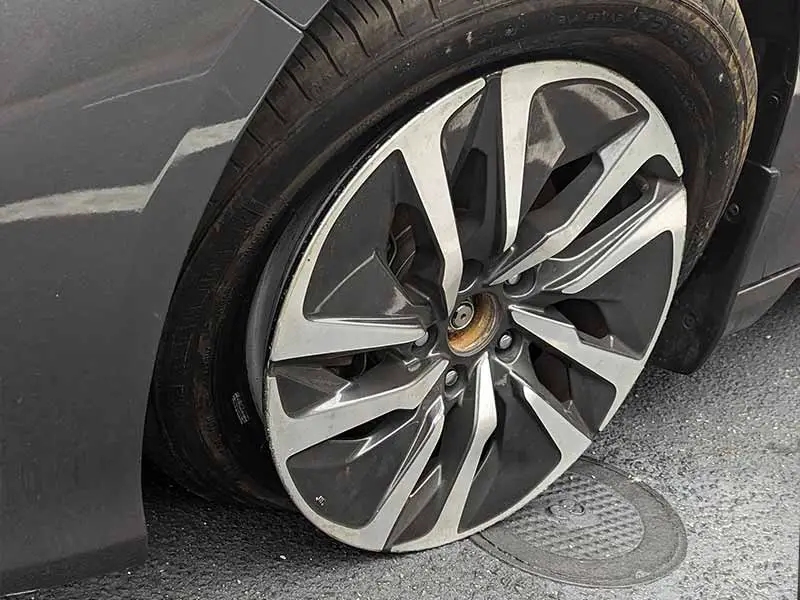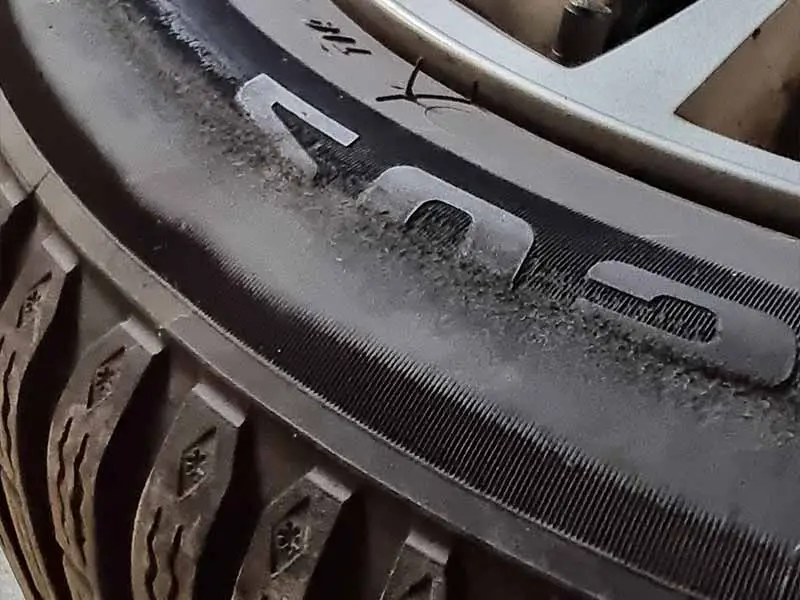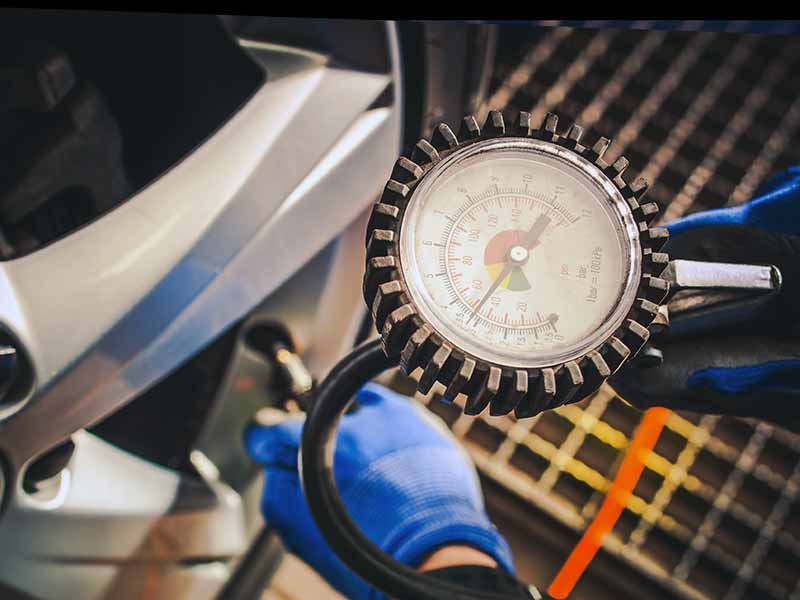Driving with low tire pressure can cause a variety of problems, from decreased fuel efficiency to reduced handling and safety. Poor gas mileage is a concern, but a tire blowout is much more worrying.
How Long Can You Drive With Low Tire Pressure?
You can drive with low tire pressure for a short distance at low speeds if you need to get to a safe location or a gas station add air to your tires if the pressure isn’t below 20 psi.
Avoid driving at highway speeds or for a longer distance. Driving on low tire pressure can be dangerous and cause a catastrophic blowout.
In addition to the risk of a blowout, driving with low tire pressure can also reduce your ability to handle the vehicle properly, making it harder to brake, turn, and maneuver in emergency situations.
Let’s take a closer look.
Effects Of Driving With Low Tire Pressure
When your tire pressure is too low, your tires can’t function at their best. Your handling and steering become compromised, and you might even notice your car pulling to one side. Plus, low tire pressure can lead to uneven wear on your tires, which can cause you to need new tires sooner than you might expect.

Driving with low tire pressure also affects your fuel economy. Underinflated tires create more rolling resistance, which means your car has to work harder to move forward, resulting in decreased fuel efficiency. This can be especially frustrating for those of us who are already feeling the pinch at the pump.
One of the most significant risks of driving on low tire pressure is the increased risk of a blowout. When your tires are underinflated, the sidewalls of your tire become more susceptible to damage, and they can even start to separate from the tire itself. This can lead to a blowout, which is not only scary but also can be very dangerous if it happens while you’re driving at high speeds.
How Low Does Tire Pressure Have To Be For The TPMS Light To Come On?
The low tire pressure warning light will come on when the pressure in one or more of your tires is 25% lower or more than the recommended pressure. So, if your recommended pressure is 32 psi, the light will come on when your tire pressure drops to about 24 psi.

It’s worth noting that TPMS is not a substitute for regular tire maintenance. You should still check your tire pressure manually every month or so and adjust it as needed. The TPMS is just an extra safety feature to help you keep an eye on your tire pressure between manual checks.
If the TPMS light does come on, don’t panic! Pull over and check your tire pressure and add air if necessary. Remember, driving on underinflated tires can be dangerous, so it’s best to address the issue immediately.
I recommend keeping a portable air compressor in your car or truck for situations like this. If your tire pressure is below 20 psi it’s unsafe to continue driving. Having an air compressor handy can be a game changer in an emergency.

Craftsman V20 Portable Tire Inflator
How Low Can A Tire Be Before It Is Unsafe?
The short answer is that any amount of low tire pressure is unsafe. Even just a few pounds per square inch (psi) of low pressure can have a significant impact on your car’s handling and safety. When your tires are underinflated, they don’t grip the road as well as they should, which can lead to longer stopping distances and decreased handling.
If you’re wondering how low is too low, it’s important to know that it varies depending on the size of your tires and the weight of your vehicle. In general, though, 20 psi is considered the minimum safe pressure to drive with low tire pressure at a low speed for a short distance in an emergency.

Low tire pressure can cause your tires to overheat, which can lead to blowouts and other dangerous situations. Don’t ignore the low tire pressure light and continue to drive with low tire pressure.
You should aim to keep your tire pressure at the manufacturer’s recommended levels, which you can find in your car’s manual or on the tire information label located on the driver’s door jamb. If your tire pressure falls below this level, it’s time to add air as soon as possible.
What Does Low Tire Pressure Feel Like?
Over time, modern truck and car tires have moved toward shorter tire sidewalls. As the sidewall height has decreased it has become harder and harder to notice when the air pressure in your tires is too low. It becomes much more noticeable in an emergency situation where you have to come to a sudden stop or change lanes at high speed. That’s when it can be too late.
One of the most common signs of low tire pressure is a noticeable decrease in handling and stability. Your car may feel like it’s swaying or wobbling, especially at high speeds or on windy days. You may also feel like your steering is less responsive than usual, or that your car is pulling to one side or the other. All of these symptoms can be caused by underinflated tires, so it’s important to check your tire pressure regularly to make sure it’s at the recommended level.

Another thing to look out for is a bumpy or rough ride. When your tires are low on air, they don’t absorb bumps and vibrations as well as they should, which can make for a less comfortable ride. You may notice that you feel every bump in the road more than usual, or that your car seems to bounce around more than it should.
Finally, low tire pressure can also cause your tires to make more noise than usual. You may hear a thumping or thudding sound coming from your tires, especially at higher speeds. This is because the low pressure causes your tires to flex and distort more than they should, which can lead to uneven wear and noisy tires.
What Does Low Tire Pressure Look Like?
It’s difficult to tell if there is low tire pressure by looking at a tire. This is for the same reason it’s difficult to feel when you have low tire pressure while driving.
The shorter sidewalls of modern tires have to be designed to be stronger and less flexible. This means there will be very little difference when looking at a tire with low tire pressure and one that is inflated to the recommended tire pressure.
If you notice one of your tires looks like it is low on air pressure because the sidewall is pushed outward at the bottom or even folded over, you can be confident that it is extremely dangerous to drive on and you’ll risk a blowout if you try to drive on it.

Is Low Tire Pressure Urgent?
Low tire pressure should always be treated as urgent. The point at which your tire pressure monitoring system triggers the low tire pressure warning light is safe to continue driving on carefully. Much beyond this point and you begin to risk a tire failure.
Having a portable air compressor and air pressure gauge handy make these situations much less inconvenient. Plus, it makes keeping your tire’s air pressure topped up much easier. Having to rely on the nearest gas station having an air pump and that it is actually in working condition can be frustrating.
What Causes Low Tire Pressure?
Some of the most common causes of low tire pressure include:
- Temperature Changes – As the weather gets colder, the air inside your tires can contract, causing the pressure to drop. Similarly, as the weather gets hotter, the air inside your tires can expand, causing the pressure to increase. That’s why it’s important to check your tire pressure regularly, especially during extreme weather conditions.
- Osmosis – Over time, your tires will naturally lose some air pressure due to osmosis. Osmosis is the process of molecules passing through objects slowly over time. That’s why it’s important to check your tire pressure regularly and add air as needed to ensure optimal safety and performance. You can expect a tire to lose between 1 and 3 psi every month.
- Punctures Or Leaks – If your tire has a puncture or leak, it can slowly lose air pressure over time. This can be caused by a variety of factors, including nails, screws, or other sharp objects on the road.
- Damaged Valve Stems – The valve stem is the small rubber piece that sticks out of your tire and allows you to add or release air pressure. If the valve stem becomes damaged or starts to leak, it can cause your tire pressure to drop.
- Faulty TPMS Sensors – Your car’s tire pressure monitoring system (TPMS) uses sensors to monitor the air pressure inside your tires. If these sensors become damaged or low on battery, they may not be able to accurately detect low tire pressure.
Resources
Below are some links you may find helpful when learning about tires
- When is your tire pressure considered to be low – Way.com
- Your tire-pressure warning light just came on. What do you do now? – Consumer Reports
Final Thoughts
When it comes to driving with low tire pressure, the general rule of thumb is to get your tires checked and inflated as soon as possible.
Driving with low tire pressure can increase your risk of a blowout, reduce your handling and control, and even affect your fuel efficiency.
In general, it’s best not to take any chances with low tire pressure, and instead, make sure to check your tire pressure regularly and maintain proper inflation levels. By doing so, you’ll help ensure a safer, more efficient driving experience for yourself and everyone on the road.
Good luck and happy motoring





